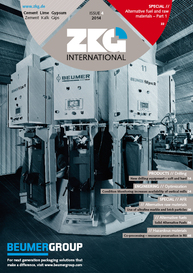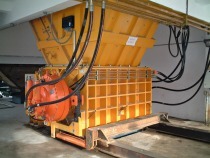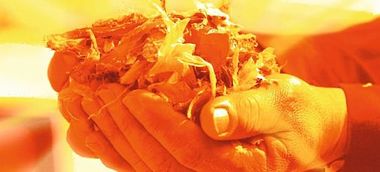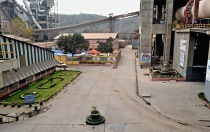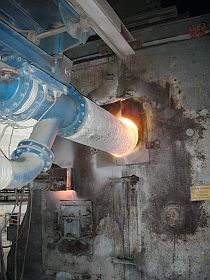Alternative Fuels and Raw Material (AFR)
Since the first oil crisis in the early 1970s, cement producers, along with other resources-intensive industries (RIIs), have been looking for ways to cut costs using alternative fuels, and have learned that they must, nonetheless, respect the needs of their processes. Today, knowledge of virtually all process, product and emissions parameters is at an unprecedentedly high level.
The outstanding performance of the cement production process, with its high temperatures of around 2000° C and superstoichiometric lime content, with its adsorbing effect, presents a certain duality for the waste-management market: Cement kilns co-processing hazardous waste are explicitly mentioned in the Stockholm Convention as the industrial process with the greatest potential for the elimination of persistent organic pollutants, on the one hand, and for the valorization of non-hazardous waste containing high levels of non-biodegradable and non-recyclable compounds, which can be pre-processed and then used as working stock, on the other hand.
This knowledge has, of course, evolved into a global concept which nonetheless offers country-specific solutions for the establishment of a win-win situation for both the public and private sectors. Cement kilns “addicted” to low-cost energy are in operation around the world close to industrial and population centers where daily accruing waste is available.
For reasons of legal certainty, waste-management planning and the legal framework need to be established by governments, on the one hand. The sourcing of suitable waste as a feedstock, its appropriate pre-treatment and technical evaluation are, on the other hand, the essential preconditions for practicable “co-processing”, the term used to describe thermal valorization, including the clinkerization of minerals. Primary calcium, silica, alumina, iron and sulfates obtained, in most cases, directly from the quarry, can thus be replaced by mineral compounds with an industrial pre-history. Fly ash, slag and flue-gas desulfurization gypsum are classical examples, each with a long tradition. In addition, evolving knowledge also generates new sources. To mention only a few examples: rejects from paper recycling contain lime and clay; Fuller’s earth from edible-oil production and foundry sand supply silica; mill scale contains usable iron, while filter-press cakes precipitated using lime all contain the main elements needed for OPC-clinker mineralization. Waste which contains carbon and/or hydrocarbons can also substitute fossil fuels when its other recycling potentials have been exhausted.
As a result of the “intention to discard” - still the predominant definition of waste - these materials may well be contaminated, and thus require analysis to determine their effects, whether positive or negative, on the environment, the process and the product. After pre-treatment and Quality Assurance, shipment and handling, these flows can be used as Alternative Raw Materials (ARM) or Alternative Fuels (AF) in the clinker-burning process, thus conserving primary resources.
Both solid and liquid waste-derived fuels and biomass need the same careful treatment, but then succeed in significantly reducing energy costs. Solid waste and biomass require crushing, screening, sifting and homogenization to assure constant quality; as well as liquid waste, which needs to be cleaned and separated, and then analyzed for calorific value, combustion behavior, its principal, minor and trace element contents, and for disruptive admixtures, such as water, etc. These pre-treatment must, of course, be followed by a logistical chain, and by facilities for storage, handling and metered feeding into the kiln. In most cases, main burners and pre-calciners require modification, including bypass and instrumentation systems appropriate to the particular process.
In economic terms, this “feed chain” must be cheaper than the costs of using primary energy. The enforcement of the applicable legal framework means that the waste producer is responsible, on the basis of the “polluter-pays” principle, for meeting all the costs of collection, pre-treatment, shipment, quality monitoring and gate fees to the cement producer, to repay all this extras, in addition to operating his daily core business.
Now, we are proud to present to you on our pages, along with other illustrious engineers, Jean-Pierre Degré, the best known specialist in the world of co-processing, who may justly be regarded as having been, during his active career, the “godfather” of this globally recognized AFR concept.
Jean-Pierre Degré spent forty-one years at Holcim, where he rose to be Group Senior Vice-President and head of the group’s AR division. During his long career, he became extremely familiar to world environmental decision-makers as an expert in this complex field, and as a delegate to the UN/SBC, the R/D & Environmental Division of the European Commission, and to various environment ministries. For more than twenty years, Jean-Pierre Degré has been developing and implementing the concept of the co-processing of waste in the resources-intensive industries.
The AFR concept is now acknowledged by NGOs, as well as by numerous international bodies and governments, and has already become part of the legal waste-management framework in a lot of countries around the world.
With our next special issues we’d like to create the practical basis for inspiring project ideas!

